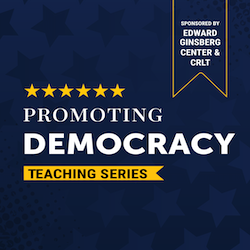This is the second of a three-part series by CRLT and the Ginsberg Center outlining strategies and resources that instructors can use to plan, frame, and facilitate conversations about the 2020 Election.

In Part 1 of this CRLT/Ginsberg Election Resource series, we encourage instructors to spend time thinking through some important pedagogical questions about disciplinary investments in the election, as well as what is at stake for students and instructors during any classroom conversation about the 2020 Election.
This guide builds from Part 1 to outline a process for planning the actual structure and facilitation of any discussions about the election, before or after November 3rd. We’ve curated important resources from CRLT and Ginsberg on high stakes discussions, ‘hot moments’ in the classroom, and civic learning into this step-by-step planning guide. While there are other ways to approach discussion planning, we aim to help you visualize a planning process that you can adapt to your own teaching context.
1. CHOOSE AN ELECTION TOPIC TO DISCUSS
Instructors will host a range of election-related conversations in their classrooms, from analyzing the election through a disciplinary lens to making space for students to debrief their reactions to the election results. Some instructors may also be thinking about what they’ll do if an ‘unexpected’ conversation arises in their course even when the election is left off the official agenda. While all of these scenarios involve ‘Election 2020’ as the discussion topic, each of these examples invokes a different set of stakes for students and instructors. We encourage you to make a plan for a specific classroom scenario in order to promote close alignment between your goals for discussion and your instructional choices.
2. IDENTIFY A ‘CRITICAL FRIEND’
Who do you trust to share ideas with and to offer you helpful critiques? All instructors can benefit from having someone to offer feedback on their discussion plan. Consider identifying a colleague or booking a consultation with CRLT or the Ginsberg Center to get feedback while you develop your approach to discussion.
Resources:
- Book a Teaching Consultation with CRLT
- Book a Consultation with Ginsberg Center staff
- Costa & Kallick’s “Through the Lens of a Critical Friend.”
3. CONSIDER THE STAKES
Before thinking about discussion prompts and activities, consider what may be at stake for you and your students during an election discussion. As noted in the first blog post in the series, like other ‘high stakes’ topics, an election discussion may implicate students’ and instructors’ personal experiences and identities, connect to firmly held values, surface hidden opinions, impact one’s sense of belonging in the course/discipline, or produce other impacts that we might describe as risk. These and other risks are present alongside potential benefits that are also at stake in a debrief. Should the discussion be facilitated well, it might correct misperceptions, increase critical literacies, promote responsible dialogue across difference, and strengthen students’ course learning. Before addressing the logistics of your discussion plan, think through what might be at stake:
- What risks will students take on in the process of participating in an election debrief?
- What are the risks for as an instructor in my particular Department/discipline?
- How might the risks be experienced differently depending on the social identities held by students’ and instructors’, or their relationships to institutional power and authority?
- What can be gained (e.g. for learning, a sense of belonging, classroom community) if this discussion is facilitated well?
4. DEFINE YOUR GOALS
The range of stakes that you anticipate in your specific teaching context should shape your discussion goals (e.g. what you want students to learn and what you want them to experience). One way to think about discussion goals is to ask yourself: What do I want to ensure happens during the discussion? What do I want to avoid? Defining and sharing with students your clearly articulated objectives can help set participant expectations and link your discussion to other course goals. Specific objectives for your election discussion may focus on disciplinary connections, policies, civic responsibilities, or the high stakes of the election. Examples include:
- Connecting the election with course learning objectives; for example, by exploring disciplinary connections and investments in the issues raised by the election.
- Making space to acknowledge the range of emotions (fear, disappointment, elation, confusion, anger, relief) that may be present within your class.
- Enhancing skills for dialogue across differences.
- Practicing the skills of critical literacy and the ability to evaluate bias in text, discourse, and other mediums.
- Analyzing the root causes or reasons for a social conflict (i.e., a past-oriented discussion).
- Exploring possible consequences or implications of the election (i.e., a future-oriented discussion).
- Planning effective actions to reduce harms experienced by students targeted by election rhetoric.
- Relating classroom discussion to the roles that students have as members within the university community and larger society.
5. CHOOSE STRUCTURES
‘Structure’ refers to the formats, activities, guidance, and resources that you will use to support your election discussion. Too often, instructors choose structures without first establishing goals and often without regard to the stakes involved. Aim for a close alignment between your goals and the structures you choose. For example, if a goal you have is to make sure every student has a voice in your election debrief, a more structured discussion activity that diversifies participation would be better than an open format that relies solely on students to volunteer. As you choose structures, ask yourself:
- What discussion formats/ activities will best further your goals?
- What discussion guidelines will be important to provide or establish with student input before starting discussion?
- How much time should you devote to this discussion?
- What resources will you have in place to support your students beyond this discussion? Think: office hours, supplementary readings, other events & organizations, etc.
Resources:
- Civic Learning Activities (section on ‘Activities to Structure or Debrief Discussions’)
- Discussion Format Ideas from CRLT
- Sample Discussion Guidelines
6. CHOOSE FACILITATION STRATEGIES
‘Facilitation strategies’ refer to the instructional moves you make during discussion to promote the learning goals, provide transparency, set (and reset) the tone, respond to and build upon student contributions, share your own thinking, and mitigate or reduce harm. While facilitation strategies are often instructors’ focus, we intentionally list this as a final step in our process to illustrate the ways that the preceding steps help create the conditions for effective facilitation. The strategies in the Resource links below will help you navigate these and other critical in-the-moment facilitation decisions:
- How will you explain your decision to devote class time to talking about the election? How will you frame your decision for your students if you decide not to spend much time?
- What language will you use to acknowledge the high stakes of the discussion?
- How will you provide a common starting point (shared learning goals, definitions, etc.) for students to engage in discussion?
- What will you do to get conversation moving if your students are silent?
- What language will you use to respond and guide students through moments of tension, emotion, and/or conflict?
Resources:
- Facilitation Strategies for High Stakes Topics (includes strategies for when you address the election OR when you decide not to)
- Facilitation Strategies for ‘Hot Moments’(i.e. sudden tension/conflict)
- IGR’s Dialogic Techniques
Teaching during this election season will undoubtedly be challenging. As always, CRLT and Ginsberg Center consultants are available to talk with any instructor about planning courses or class sessions -- or responding to difficult moments if they arise. You can make an appointment through CRLT’s website or use Ginsberg Center’s Support Request Form.
Coming up:
In the final blog of this three-part series, we will outline ways that instructions can help students 1) channel their reactions to Election 2020 into action and 2) explore the many ways that they can continue to contribute to their communities through civic engagement, regardless of political affiliation.
- Log in to post comments
- 2431 views






